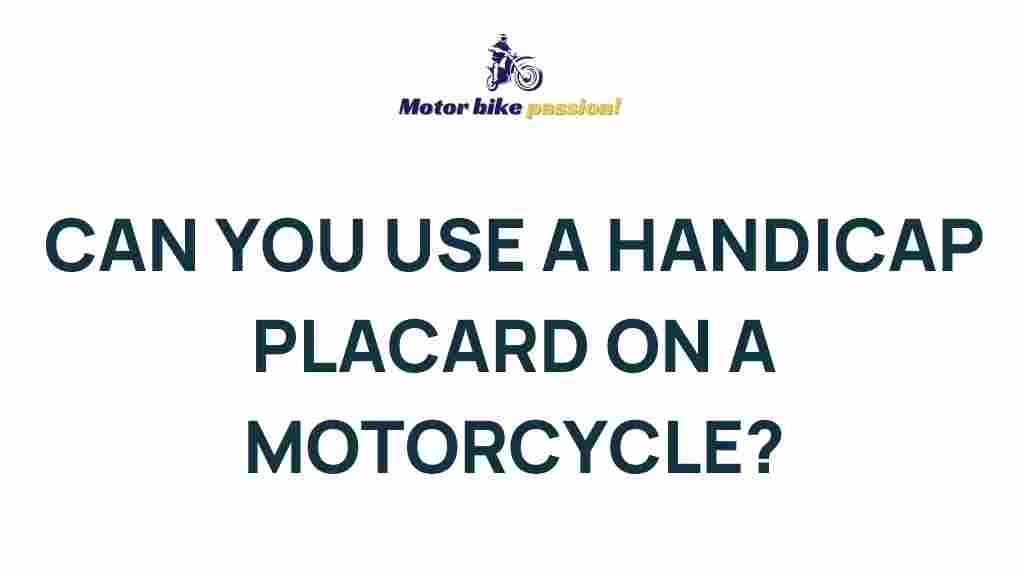Unveiling the Mystery: Can Motorcyclists Utilize Handicap Placards?
In recent years, the conversation surrounding accessibility and parking permits has expanded to include various modes of transportation. One question that often arises is whether motorcyclists can utilize handicap placards. This article will dive into the details, examining the eligibility criteria, legal considerations, and practical implications of using a handicap placard on a motorcycle. With the focus on enhancing accessibility for all, we will clarify the rules and provide guidance for motorcyclists who may need to use a mobility aid.
Understanding Handicap Placards and Their Purpose
Handicap placards are special parking permits issued to individuals with disabilities, allowing them to park in designated accessible spaces. The primary purpose of these placards is to promote mobility and accessibility for individuals who may have difficulty walking or require special accommodations due to their disabilities.
Who Qualifies for a Handicap Placard?
Eligibility for a handicap placard generally includes individuals who have specific medical conditions that severely limit their mobility. These conditions may include:
- Severe arthritis
- Blindness or visual impairments
- Respiratory conditions
- Neurological conditions
- Permanent disability
To qualify, individuals must typically provide medical documentation confirming their condition when applying for a handicap placard.
Can Motorcyclists Use Handicap Placards?
The answer to whether motorcyclists can use handicap placards varies by state and local regulations. Some jurisdictions allow the use of handicap placards on motorcycles, while others do not. It is crucial for motorcyclists to understand their local laws regarding the use of these permits.
State Regulations and Variability
In states where handicap placards are permitted for motorcycles, motorcyclists must follow specific guidelines. Here are some common regulations:
- Motorcyclists must display the handicap placard visibly when parked in accessible spaces.
- The motorcycle must be registered in the name of the individual who possesses the handicap placard.
- Some states may require a separate motorcycle-specific permit or sticker.
It is essential to consult your local Department of Motor Vehicles (DMV) or equivalent authority to understand the specific regulations applicable to your location.
How to Apply for a Handicap Placard as a Motorcyclist
If you are a motorcyclist and believe you qualify for a handicap placard, here is a step-by-step process to apply:
Step 1: Determine Your Eligibility
Before applying, ensure you meet the eligibility criteria for a handicap placard. Obtain the necessary medical documentation from your healthcare provider to support your application.
Step 2: Visit Your Local DMV or Equivalent Authority
Go to your local DMV office or visit their website to find the application forms for handicap placards. Make sure to check if they have specific forms for motorcycle users.
Step 3: Complete the Application Form
Fill out the application form carefully. Include all required information, such as your personal details, motorcycle registration number, and details about your disability.
Step 4: Submit Your Application
Submit your completed application along with any required documentation, such as proof of your disability and your motorcycle registration. Some states may allow online submissions, while others may require in-person applications.
Step 5: Await Approval
Once your application is submitted, it may take some time for processing. Keep an eye on your mail for your handicap placard, and ensure you understand the rules regarding its use on your motorcycle.
Troubleshooting Common Issues
While applying for a handicap placard as a motorcyclist, you may encounter some common issues. Here are tips to resolve them:
Issue 1: Application Denied
If your application for a handicap placard is denied, check the following:
- Ensure that all required documents were submitted.
- Confirm that you meet the medical criteria for a handicap placard.
- Contact the DMV for clarification on the specific reasons for the denial.
Issue 2: Placard Not Received
If you have not received your placard after a reasonable waiting period, consider these steps:
- Check with your local DMV to confirm that your application was processed.
- Verify that you provided accurate contact information.
- Ask if there are any delays in processing applications.
Issue 3: Misuse of Placard
Ensure you are using the handicap placard according to the regulations. Misuse can result in fines or the revocation of the permit. Always:
- Display the placard properly when parked.
- Never lend your placard to someone else.
- Follow local laws regarding accessible parking.
The Importance of Accessibility for Motorcyclists
Accessibility is crucial for everyone, including those who choose to ride motorcycles. By understanding the rules surrounding handicap placards, motorcyclists can better navigate parking and accessibility issues. Here are some reasons why accessibility matters:
- **Encourages independence**: For individuals with mobility challenges, being able to park closer to their destination promotes independence.
- **Enhances safety**: Accessible parking reduces the risk of accidents when navigating longer distances from parking areas.
- **Promotes inclusivity**: Ensuring everyone has access to public spaces fosters a more inclusive society.
Conclusion
In conclusion, the use of handicap placards by motorcyclists can be a complex but essential topic. While some jurisdictions allow it, it is vital for motorcyclists to understand their local regulations to ensure they are compliant. The process of applying for a handicap placard involves determining eligibility, completing necessary forms, and submitting documentation to the appropriate authorities.
Accessibility is a fundamental right, and by equipping ourselves with the right knowledge, we can foster a more inclusive environment for all road users. For more information on disability rights and accessibility, consider visiting this resource, and consult your local DMV to ensure you have the most accurate and updated information.
This article is in the category Basic Guides and created by MotorBikePassion Team
